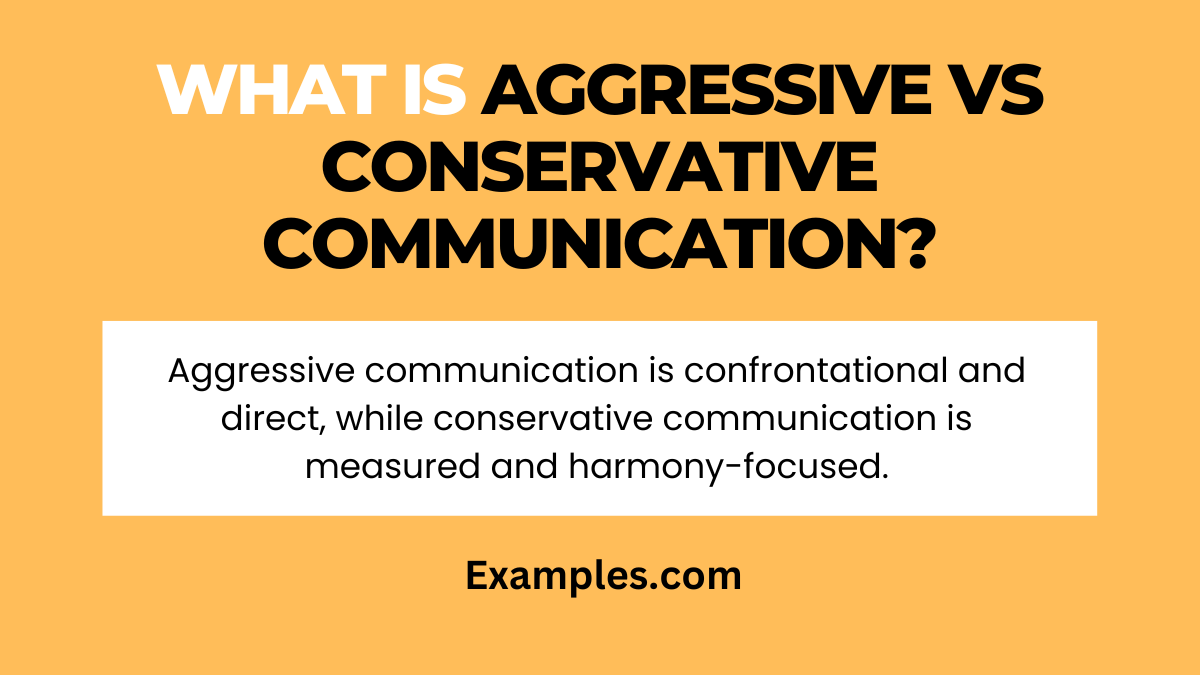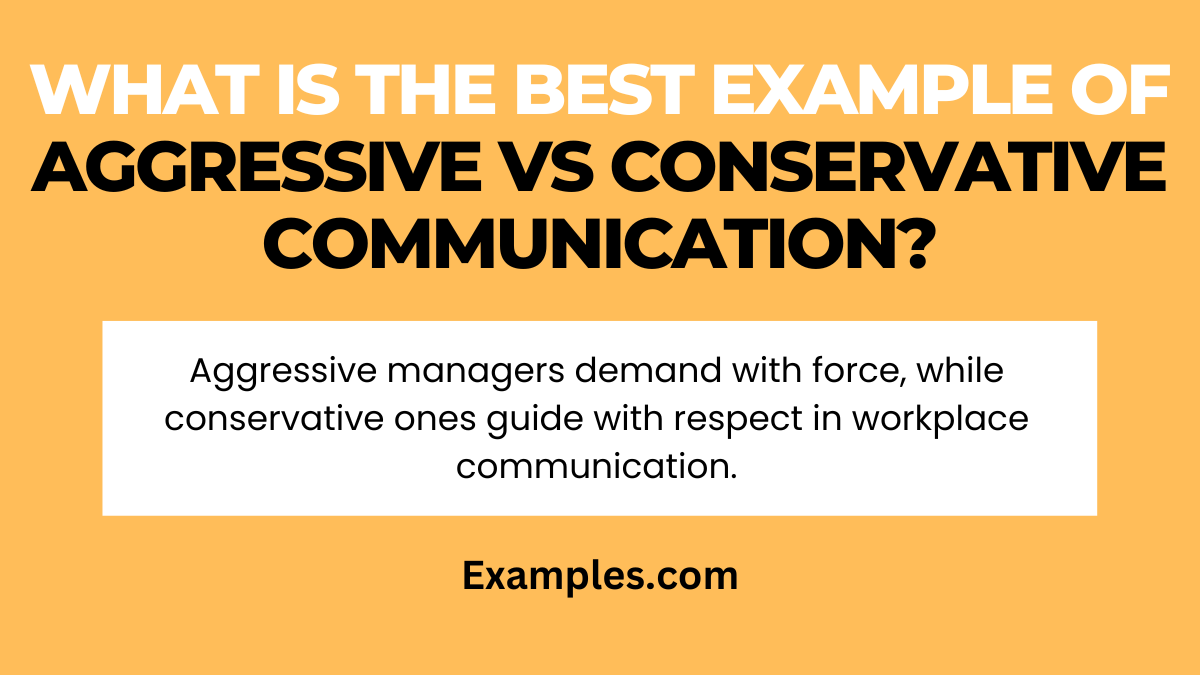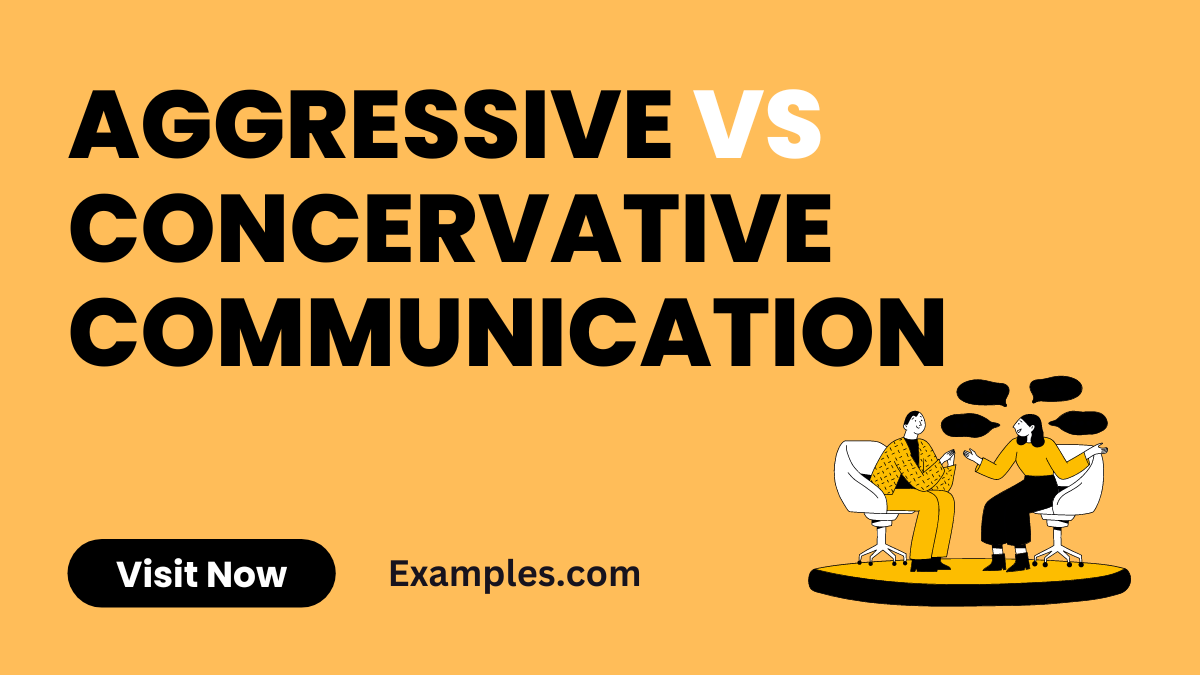Aggressive vs Conservative Communication – 19+ Examples
Aggressive versus conservative communication reflects two distinct approaches in oral communication styles. Aggressive communication often involves direct confrontation, verbal aggression, and demanding language, whereas conservative communication is characterized by a more restrained, cautious, and respectful approach. Understanding the nuances between these styles is crucial for effective interpersonal interactions, especially in diverse settings like the workplace or personal relationships. This comparison offers insights into how each style impacts communication dynamics and the potential outcomes of their usage.
What is Aggressive vs Conservative Communication?

Aggressive vs conservative communication defines two contrasting communication methods. Aggressive communication is marked by direct confrontation, verbal attacks, and often an overbearing attitude. It’s straightforward but can be perceived as hostile or intimidating. On the other hand, conservative communication is more measured and circumspect, characterized by careful language choice, a focus on maintaining harmony, and often a more passive approach. Each style has its context where it can be effective, but understanding their impact is key to successful communication.
What is the Best Example of Aggressive vs Conservative Communication?

A prime example of aggressive vs conservative communication can be observed in a workplace scenario. An aggressive manager might demand immediate results, using verbal aggression and intimidation tactics, potentially leading to a stressed work environment. Conversely, a conservative manager would communicate expectations clearly but in a more restrained and respectful manner, aiming to preserve a positive and cooperative atmosphere. These contrasting styles highlight the importance of adapting communication methods to suit various interpersonal and professional contexts.
Difference Between Aggressive and Conservative Communication

Aggressive communication is characterized by a confrontational, forceful style, often perceived as dominating or intimidating. It involves direct and blunt language, sometimes bordering on rudeness, and may include personal attacks. In contrast, conservative communication is calm, polite, and indirect, focusing on respect and consideration for others’ opinions. Conservative communicators aim for peaceful conflict resolution, valuing mutual understanding, whereas aggressive communicators often disregard others’ feelings, focusing on winning arguments rather than finding collaborative solutions.
| Aggressive Communication | Conservative Communication |
|---|---|
| Often involves loud and forceful tone | Typically characterized by calm and gentle tone |
| Direct and blunt, sometimes to the point of rudeness | Polite and indirect, ensuring not to offend |
| May include personal attacks or insults | Focuses on the issue, not the person |
| Can be seen as domineering or intimidating | Respectful and considerate of others’ opinions |
| Typically results in escalating conflict | Aims to de-escalate and resolve conflict peacefully |
| Often disregards others’ feelings or points of view | Values and considers others’ feelings and perspectives |
| Can be seen as self-centered or egotistical | Seen as cooperative and collaborative |
| Focus on winning the argument | Focus on finding a mutual understanding or solution |
10 Examples of Aggressive Communication
Aggressive communication can be detrimental to relationships. Here are 10 examples with explanations:
- Bold: “You’re always late! You have no respect for my time!” – This statement blames and criticizes, escalating conflict.
- Demanding: “You better do it my way, or else!” – Demanding compliance through intimidation.
- Commanding: “Stop talking and listen to me!” – Dismissing others’ input and asserting dominance.
- Blaming: “This mess is your fault!” – Shifting blame without taking responsibility.
- Critical: “You’re so incompetent; I can’t believe I have to work with you!” – Constantly criticizing undermines confidence.
- Verbally Abusive: “You’re worthless and pathetic!” – Hurtful words that emotionally harm.
- Threatening: “If you don’t do what I say, you’ll regret it!” – Using fear to control.
- Sarcasm: “Oh, great job, Einstein!” – Mocking and belittling others.
- Interrupting: “I don’t care what you think; I’m speaking!” – Not allowing others to voice their opinions.
- Yelling: “I’ve had enough of you!” – Using loud, aggressive tone to intimidate.
10 Examples of Submissive Communication
Submissive communication can hinder self-expression. Here are 10 examples with explanations:
- Avoidance: “I don’t want to upset anyone, so I’ll keep quiet.” – Avoiding conflict by not expressing opinions.
- Apologizing Excessively: “I’m so sorry for everything, even if it’s not my fault.” – Constantly apologizing, even when not responsible.
- Always Agreeing: “You’re right, whatever you say is correct.” – Agreeing to avoid disagreement.
- Self-Doubt: “I’m not sure if I can do it, but I’ll try.” – Expressing doubt in one’s abilities.
- Lack of Assertiveness: “Um, I guess if you don’t mind, I can do it.” – Failing to assert preferences.
- Over-Accommodating: “I’ll do all the work; you don’t need to help.” – Taking on excessive responsibilities.
- Frequent Deferring: “I’ll let others decide; I don’t mind.” – Allowing others to make decisions.
- Insecurity: “I’m not worthy of your attention or time.” – Feeling unworthy and submissive.
- Fear of Disapproval: “I don’t want anyone to be mad at me.” – Prioritizing others’ approval over own needs.
- Excessive Politeness: “Please, if it’s not too much trouble, could you possibly…” – Using overly polite language to avoid imposing.
Comparison Between Aggressive and Conservative Communication
- Nature of Expression: Aggressive communication often involves verbal attacks and intimidation tactics, characterized by a confrontational and overpowering approach. Conservative communication, in contrast, is marked by restraint and thoughtfulness, avoiding extreme expressions.
- Impact on Relationships: While aggressive communication can lead to conflicts and resentment due to its hostile body language and blame tactics, conservative communication fosters a more harmonious and respectful interaction.
- Emotional Expression: Aggressive communicators tend to express anger and frustration openly, using shouting and yelling, whereas conservative communicators are more likely to internalize their emotions, maintaining a calm demeanor.
- Response to Conflict: In conflict situations, aggressive communication may involve direct confrontation and manipulation, while conservative communication leans towards negotiation and compromise.
- Perception by Others: Aggressive communicators are often perceived as domineering and disrespectful, due to their overbearing behavior and dismissive attitude. Conservative communicators are typically seen as approachable and reasonable.
- Assertiveness Level: Aggressive communication crosses the line of assertiveness into aggressiveness, often involving blaming and being verbally abusive. Conservative communication remains within the bounds of polite assertiveness.
- Decision-Making Approach: Aggressive communication is often quick and impulsive, driven by impulsive aggression. In contrast, conservative communication involves careful consideration and deliberation.
- Physical Expressions: Hostile body language like pointing fingers and invading personal space is common in aggressive communication. Conservative communicators maintain respectful physical boundaries.
- Influence on Group Dynamics: In a group setting, aggressive communication can create a tense atmosphere, often involving intimidation tactics. Conservative communication promotes a more collaborative and inclusive environment.
- Long-Term Consequences: Aggressive communication can damage relationships and reputations over time, while conservative communication builds trust and credibility.
Relationship Between Aggressive and Conservative Communication
- Conflict Resolution: Aggressive communication often escalates conflicts with its blame and accusation tactics, while conservative communication seeks to de-escalate and resolve conflicts amicably.
- Communication Outcomes: The outcome of aggressive communication is often resistance and hostility, due to its verbal attacks and manipulation. Conservative communication, on the other hand, leads to more constructive and positive outcomes.
- Psychological Impact: Aggressive communication can cause psychological stress and anxiety, marked by impulsive aggression and verbal abuse. Conservative communication is less likely to cause such stress.
- Effectiveness in Different Situations: While aggressive communication may be effective in commanding immediate attention, its intimidation tactics can backfire. Conservative communication is generally more effective in building long-term relationships.
- Influence on Decision Making: Aggressive communicators often influence decisions through demanding and commanding tactics. Conservative communicators influence decisions through logical reasoning and collaboration.
- Cultural Acceptance: Different cultures have varying levels of acceptance for aggressive communication, with some viewing it as a sign of strength and others as inappropriate. Conservative communication is generally more universally accepted.
- Personal Boundaries: Aggressive communication often violates personal boundaries, with overbearing behavior and hostile body language. Conservative communication respects personal space and boundaries.
- Adaptability: Aggressive communicators may struggle to adapt their style in sensitive situations, while conservative communicators can adjust their approach as needed.
- Self-Awareness: Aggressive communication often lacks self-awareness, failing to recognize the impact of intimidation and verbal attacks. Conservative communicators are more likely to be self-aware and considerate.
- Leadership Styles: Aggressive communication is associated with autocratic leadership, marked by demanding and commanding attitudes. Conservative communication aligns with democratic and participative leadership styles.
Aggressive and conservative communication styles significantly impact interpersonal interactions. Aggressive communication, characterized by verbal attacks and intimidation tactics, can lead to conflict and strained relationships. In contrast, conservative communication, marked by restraint and respect, fosters harmony and understanding. This guide highlights the importance of choosing communication styles wisely, emphasizing the benefits of conservative over aggressive approaches in most interpersonal scenarios.



